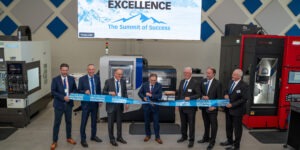MONITORED COOLING FOR ROBOT SPOT WELDING UNITS
Dr. Egon Huefner of Bürkert Werke GmbH & Co. KG explores how the fast detection of leaks in the cooling system enhances the reliability of welding robots.
Posted: May 18, 2011
During welding operations, the fast detection of leaks in the cooling system enhances the reliability of welding robots.
Robot spot welding units are widely used in the highly automated production lines of the automotive industry and its suppliers. To meet the stringent quality requirements for welding while ensuring 100-percent availability and reliability of the individual components and welding robots, controlled optimised cooling of the welding is imperative. Operators must therefore be in a position to quickly and accurately detect any leaks in the cooling system caused by worn electrode caps and other defects.
In the assembly halls of car manufacturers, there are often several hundred spot welding robots at work. In the production of cars along large assembly lines, robots produce up to 40 high-precision spot welds within extremely short cycle times, in three shifts around the clock. In order to dissipate the heat produced by the high currents in the welding process, it is necessary to cool the tips of the electrode clamps commonly known as electrode caps. The copper electrodes used in the process are designed as wear parts and must be regularly replaced. Without cooling the tips, the electrodes would, however, be worn much more quickly. This would not only result in higher costs due to electrode failure, but also in loss of production due to frequent shutdowns for maintenance of the equipment. To prevent this, the electrode caps of spot welding robots are cooled with six to eight litres of water per minute. The cooling water has a temperature of between 20 and 40 deg C and is supplied at a pressure of up to 10 bar.
Despite continuous cooling, the electrode caps remain highly susceptible to wear, so that there is a high risk of leakage of cooling water in the plant. Such leaks do not only lead to downtimes but can also cause damage to sensitive plant components such as electronic parts. In addition, there is a risk of injury to the machine operator from water escaping under pressure The systems used to cool the electrode caps must therefore be able to detect leaks quickly and to interrupt coolant flow instantly by means of suitable shut-down devices. In the event of a defect at an electrode cap, the cooling system must respond within less than half a second. Depending on the quality of the cooling water, the task in hand and the potential effect of a leak, car manufacturers have chosen different solutions that are discussed here in more detail.
CONVENTIONAL LARGE-SIZE SYSTEM
Electrode caps in spot welding robots must be replaced when leakage occurs or the cap is lost due to wear. In addition, operators have adopted strategies to prevent downtimes, whereby electrode caps are replaced at the beginning and end of each shift as a routine measure. Cooling systems for electrode caps typically consist of components from various manufacturers. In such systems, a flow controller, a feed and return valve and possibly some pneumatic control valves are connected through tubes to each other. One of the main disadvantages of this type of system is its large size. Dimensions of 1000 x 600 mm are fairly common.
In plants where several robots are operated in close proximity to each other, the space requirements for such systems can pose a problem. Another disadvantage of these systems lies in the sensory equipment. The flow controllers that are normally used here are inexpensive, but their switching point is not very accurate. This significantly limits the flexibility of the system. Due to the large hysteresis of the flow controllers, response time in the event of a leak is rather long. In addition, these controllers are unable to respond adequately to small flow-rate deviations of less than one litre per minute or small leaks (caused, for example, by hairline cracks in the feed or return line), as they often fail to switch altogether or switch too slowly to close the cooling water circuit within the necessary time limit.
COMPACT, INTEGRATED TAILOR-MADE SOLUTIONS
The combination of sensory equipment, valve technology and controllers in small compact units provides a flexible and reliable solution for these problems. Such high-performance integrated systems can be assembled according to the requirements of the operator and the specific application from predesigned modules. This approach allows for the production of tailor-made intelligent systems for the cooling of electrode caps that guarantee zero leakage in the event of a loss of an electrode cap or during replacement.
Depending on the type of electrode clamps used, these modular cooling systems can be equipped with pneumatic or hydraulic drives respectively. Operators of electrode clamps with servo motor drives are often looking for cooling and monitoring systems that are electrically controlled. Electrically driven electrode clamps are mainly used in applications where extremely accurate positioning is required. In practice, pneumatically operated electrode clamps are, however, still the more popular and reliable solution, as such clamps can easily be positioned with the accuracy typically required for spot welding applications.
MODULAR COOLING SYSTEMS WITH PNEUMATIC DRIVE ELEMENTS
The integrated cooling water-monitoring block consists of a pilot valve, a feed and return valve and a flow-rate sensor (see Figure 1). The main advantages of the block solution are its compact size and the option to provide additional connections for secondary cooling processes such as for example a thyristor cooling system.
During operation, the pilot valve is switched in such a way that both the feed and return valves are opened. The cooling water can thus flow freely through the electrode clamps. As soon as a leak occurs, the flow-rate sensor actuates the pilot valve. As a consequence, the feed valve is switched to close the cooling water circuit. The return valve closes with a delay that is preset by means of a restrictor. This delayed shut-off ensures that the pressure in the electrode clamps is reduced through the return valve. The backpressure occurring in the return lines continues pressurising the lines of the electrode clamps. This pressure can reach up to 2 bar so that some small leakage still occurs when the electrode caps are being replaced.















